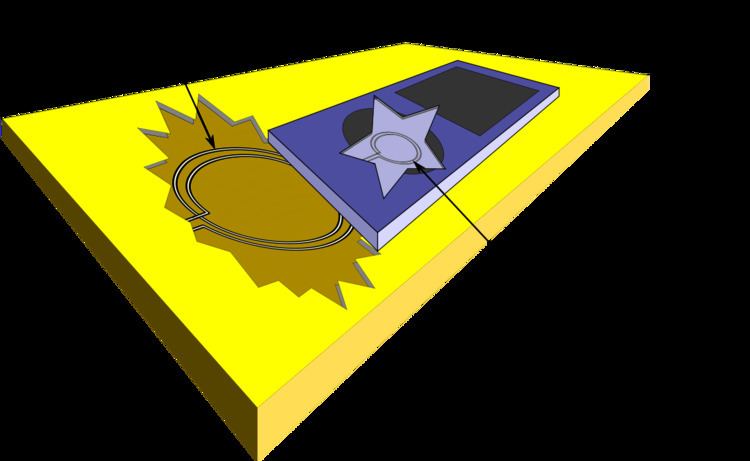 | ||
Inductive charging (also known as wireless charging) uses an electromagnetic field to transfer energy between two objects through electromagnetic induction. This is usually done with a charging station. Energy is sent through an inductive coupling to an electrical device, which can then use that energy to charge batteries or run the device.
Contents
- Advantages
- Disadvantages
- Standards
- Portable electronics and devices
- Transportation
- Research and other
- Electric vehicles
- References
Induction chargers use an induction coil to create an alternating electromagnetic field from within a charging base, and a second induction coil in the portable device takes power from the electromagnetic field and converts it back into electric current to charge the battery. The two induction coils in proximity combine to form an electrical transformer. Greater distances between sender and receiver coils can be achieved when the inductive charging system uses resonant inductive coupling. Recent improvements to this resonant system include using a movable transmission coil (i.e. mounted on an elevating platform or arm) and the use of other materials for the receiver coil made of silver plated copper or sometimes aluminium to minimize weight and decrease resistance due to the skin effect.
Advantages
Disadvantages
Newer approaches reduce transfer losses through the use of ultra thin coils, higher frequencies, and optimized drive electronics. This results in more efficient and compact chargers and receivers, facilitating their integration into mobile devices or batteries with minimal changes required. These technologies provide charging times comparable to wired approaches, and they are rapidly finding their way into mobile devices.
For example, the Magne Charge vehicle recharger system employs high-frequency induction to deliver high power at an efficiency of 86% (6.6 kW power delivery from a 7.68 kW power draw).
Standards
Portable electronics and devices
Transportation
Research and other
Electric vehicles
Magne Charge inductive charging was employed by several types of electric vehicles around 1998, but was discontinued after the California Air Resources Board selected the SAE J1772-2001, or "Avcon", conductive charging interface for electric vehicles in California in June 2001.
In 2009, Evatran began development of Plugless Power, an inductive charging system they claim is the world’s first hands-free, plugless, proximity charging system for Electric Vehicles. With the participation of the local municipality and several businesses, field trials were begun in March 2010. The first system was sold to Google in 2011 for employee use at the Mountain View campus. Evatran began selling the Plugless L2 Wireless charging system to the public in 2014.
Researchers at the Korea Advanced Institute of Science and Technology (KAIST) have developed an electric transport system (called Online Electric Vehicle, OLEV) where the vehicles get their power needs from cables underneath the surface of the road via non-contact magnetic charging (where a power source is placed underneath the road surface and power is wirelessly picked up on the vehicle itself). As a possible solution to traffic congestion and to improve overall efficiency by minimizing air resistance and so reduce energy consumption, the test vehicles followed the power track in a convoy formation. In July 2009, the researchers successfully supplied up to 60% power to a bus over a gap of 12 cm.
In one inductive charging system, one winding is attached to the underside of the car, and the other stays on the floor of the garage.
The major advantage of the inductive approach for vehicle charging is that there is no possibility of electric shock, as there are no exposed conductors, although interlocks, special connectors and RCDs (ground fault interruptors, or GFIs) can make conductive coupling nearly as safe. An inductive charging proponent from Toyota contended in 1998 that overall cost differences were minimal, while a conductive charging proponent from Ford contended that conductive charging was more cost efficient.
In 2010 onwards, car makers are signalling their interest in wireless charging as another piece of the digital cockpit. A group was launched in May 2010 by the Consumer Electronics Association to set a baseline for interoperability for chargers. In one sign of the road ahead a General Motors executive is chairing the standards effort group. Toyota and Ford managers said they also are interested in the technology and the standards effort.
Daimler’s Head of Future Mobility, Professor Herbert Kohler, however have expressed caution and said the inductive charging for EVs is at least 15 years away (from 2011) and the safety aspects of inductive charging for EVs have yet to be looked into in greater detail. For example, what would happen if someone with a pacemaker is inside the vehicle? Another downside is that the technology requires a precise alignment between the inductive pick up and the charging facility.
In November 2011, the Mayor of London, Boris Johnson, and Qualcomm announced a trial of 13 wireless charging points and 50 EVs in the Shoreditch area of London's Tech City, due to be rolled out in early 2012.
In October 2014, the University of Utah in Salt Lake City, Utah added an electric bus to its mass transit fleet that uses an induction plate at the end of its route to recharge. UTA, the regional public transportation agency, plans to introduce similar buses in 2018.
In January 2015, eight electric buses were introduced to Milton Keynes, England, which utilises inductive charging in the road at either end of the journey to prolong overnight charges.
